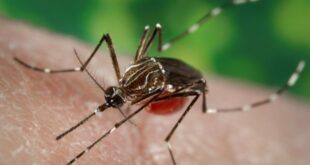Relief assessment underway by provincial and federal governments.
Producers in some parts of southern Saskatchewan are already struggling with drought this summer. Now grasshoppers can once again be added to the list of woes.
The situation is so severe south of Saskatoon that the RM of Dundurn has declared an agricultural disaster.
“On the livestock side, we’ve had to go through our pasture a lot faster than we normally would. And some stuff that we were trying to save, the grasshoppers moved in and cleaned it off before I could get any cattle onto it,” area rancher and deputy reeve Ben Wilson told CBC Radio’s The Afternoon Edition last week.
An AgriRecovery assessment from the provincial and federal governments is now underway to see how they can financially help producers affected by the damage caused by drought and the subsequent grasshopper infestations.
Dan Johnson, an environmental science professor at the University of Lethbridge who has long studied grasshoppers, said the warm and dry weather is the biggest factor.
He said it’s too late in the season for moisture to get rid of them this year.
“The tiny ones that hatch and are very small at the beginning can’t take it physically, so they don’t grow and can get attacked by disease. But once they get to the stage they’re at now — they have a waxy covering — they can hunker down into the grass and wait the rain out,” he said on CBC Radio’s Saskatoon Morning.

Johnson’s advice to producers is to keep an eye on where the bugs are laying eggs in August and September.
“Then they can know where to look in the spring for hatching. Information in the spring is really important, because if they have a long, long extended hatch, that can be a problem,” he said.
This year’s provincial grasshopper forecast showed numbers increasing from last year, with the long, dry, warm late summer and fall in many parts of the province providing good conditions for egg laying.
Crops in the south-central, southwestern and southeastern regions have been among the hardest hit. Only 10 of 1,134 sites across Saskatchewan reported no grasshoppers, the report shows.
The latest crop report
Thursday’s crop report indicates the most damage this past week is from the dry conditions and grasshoppers.
However, the warm weather has helped fields in most parts of the province flourish.
The heat allowed haying to progress quickly, with only 13 per cent of the first cut still standing and 71 per cent baled or silaged. The report said the quality of the hay ranges from fair to excellent, with the majority rated as “good.”
Pockets of moisture helped boost topsoil moisture levels in many areas, but “the drought conditions in the southwest and west-central regions were not abated by the trace amounts of moisture or localized thundershowers,” the report said.
The province reminds producers, especially those dealing with the dry conditions, that the Farm Stress Line is available to provide support toll free at 1-800-667-4442.
With files from CBC Radio’s The Afternoon Edition and Saskatoon Morning
*****
Credit belongs to : www.cbc.ca
 Atin Ito First Filipino Community Newspaper in Ontario
Atin Ito First Filipino Community Newspaper in Ontario






